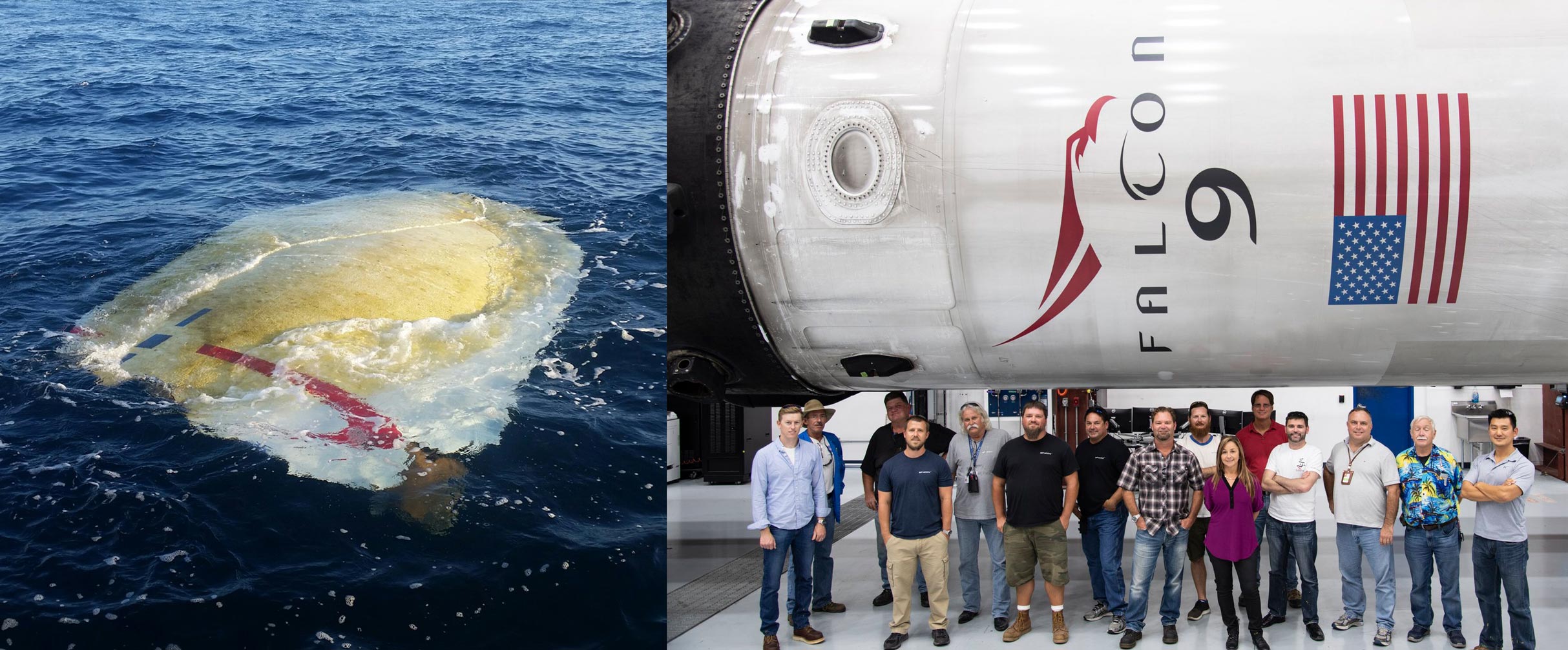

SpaceX
SpaceX Falcon 9 Block 5 booster preps for next launch as fairing fragments surface
As part of a recent 10-year anniversary celebration of SpaceX’s first successful launch to reach orbit, Falcon 9 B1047 was spotted undergoing inspections and refurbishment after the Block 5 booster’s launch debut, placing the 7-ton Telstar 19V communications satellite in orbit on July 22nd.
Meanwhile, a bit north of B1047’s cozy Cape Canaveral refurbishment hangar, battered fragments of a Falcon 9 payload fairing half – part of the very same Telstar 19V mission – were discovered by a fisherman off the coast of South Carolina.
https://twitter.com/SpaceXJobs/status/1045832573471969281?ref_src=twsrc%5Etfw%7Ctwcamp%5Etweetembed%7Ctwterm%5E1045832573471969281&ref_url=https%3A%2F%2Fwww.teslarati.com%2Fwp-admin%2Fpost.php%3Fpost%3D84909%26action%3Dedit
A tale of two halves
Around nine minutes after lifting off from SpaceX’s LC-40 pad, Falcon 9 B1047 gracefully landed on drone ship Of Course I Still Love You (OCISLY), followed soon after by confirmation of Falcon 9 Block 5’s second launch success. Perhaps a tad toasty after what one might call a ‘medium-well’ reentry, the upgraded booster was otherwise perfectly intact. A minute after B1047 separated from Falcon 9’s upper stage and Telstar 19V payload, the fairing – tasked with protecting the satellite from the stresses of high-speed atmospheric flight – was jettisoned from the second stage, splitting into two halves and falling away from the rocket in order to save precious mass on S2’s push towards orbit.
Falcon 9’s first stage separates from the upper stage for quite different reasons, cued quite literally by its propellant tanks essentially reaching “empty” – albeit an “empty” that typically includes some fumes for the booster’s safe recovery. The payload fairing, on the other hand, is detached from the second stage the moment that Falcon rises above a particular point in Earth’s atmosphere, only exposing its sensitive satellite(s) to the elements once in near-vacuum conditions. Ultimately, fairing halves separate from Falcon 9 at velocities significantly higher than that of the booster but are subjected to far more forgiving reentry conditions, requiring just a minimal of thermal protection to make it to (or just above…) the ground/ocean unscathed.
Detailed images of GO Pursuit returning to Port Canaveral this afternoon with a partial fairing half following Sunday’s launch of Falcon 9 and Telstar 19V. Damage is no surprise, as these east coast fairings — for now — land in the water. pic.twitter.com/AxkwUQH67b
— John Kraus (@johnkrausphotos) July 24, 2018
SpaceX recently began seriously attempting to recover Falcon 9 payload fairings, albeit almost exclusively during West Coast launches in order to let Mr. Steven attempt to catch the parasailing halves in the Pacific Ocean. Thus far, SpaceX engineers and technicians have not yet solved the challenging problems, although fairing halves have reportedly landed as few as 50 meters from Mr. Steven’s grasp and at least five have been recovered intact after landing gently on the ocean surface. On the East Coast, Falcon fairings are not nearly as lucky, typically alternating between smashing directly into the ocean and landing gently upon it, depending SpaceX’s need for experimental recovery data.
By all appearances, B1047’s fairing halves both plummeted – unarrested – into the Atlantic, shattering into pieces of fragile carbon fiber-aluminum honeycomb. Thanks to the extremely lightweight nature of their composition, even waterlogged fairing fragments tend to float almost indefinitely, winding up in far-flung places many hundreds or thousands of miles from the point of impact. A particularly large fairing fragment from Telstar 19V clearly survived its greater halve’s violent ends, floating its way 600-800 miles northwest to the coast of South Carolina. After taking photos, the fisherman rather poetically let it float away, permitting it several more weeks of freedom before washing up on some shoreline and making its way onto eBay.
- A Falcon 9 fairing fragment was discovered floating off the coast of South Carolina two months after launching with Telstar 19V. (TheHullTruth /u/gofish)
- Telstar 19V’s Falcon fairing artwork, a dead-ringer for the fairing flotsam. (SpaceX)
- B1047 returned safe and sound to Pad 39A for refurbishment less than a week after launching and landing. (Instagram /u/d_lo_ags)
Ultimately, SpaceX engineers and technicians will continue to work towards successful, reliable, and routine fairing recoveries, inevitably experiencing many failures before a functional solution is found and optimized, just like the teams that brought Falcon 9 first stage recovery from blueprint to reality. In the meantime, serendipitous events like this will continue to serve as both stark reminders of the unforgiving hurdles along the path to orbital-class rocket hardware recovery and the undeniable fact that it already can and has been done before.
News
SpaceX launches Ax-4 mission to the ISS with international crew
The SpaceX Falcon 9 launched Axiom’s Ax-4 mission to ISS. Ax-4 crew will conduct 60+ science experiments during a 14-day stay on the ISS.

SpaceX launched the Falcon 9 rocket kickstarting Axiom Space’s Ax-4 mission to the International Space Station (ISS). Axiom’s Ax-4 mission is led by a historic international crew and lifted off from Kennedy Space Center’s Launch Complex 39A at 2:31 a.m. ET on June 25, 2025.
The Ax-4 crew is set to dock with the ISS around 7 a.m. ET on Thursday, June 26, 2025. Axiom Space, a Houston-based commercial space company, coordinated the mission with SpaceX for transportation and NASA for ISS access, with support from the European Space Agency and the astronauts’ governments.
The Ax-4 mission marks a milestone in global space collaboration. The Ax-4 crew, commanded by U.S. astronaut Peggy Whitson, includes Shubhanshu Shukla from India as the pilot, alongside mission specialists Sławosz Uznański-Wiśniewski from Poland and Tibor Kapu from Hungary.
“The trip marks the return to human spaceflight for those countries — their first government-sponsored flights in more than 40 years,” Axiom noted.
Shukla’s participation aligns with India’s Gaganyaan program planned for 2027. He is the first Indian astronaut to visit the ISS since Rakesh Sharma in 1984.
Axiom’s Ax-4 mission marks SpaceX’s 18th human spaceflight. The mission employs a Crew Dragon capsule atop a Falcon 9 rocket, designed with a launch escape system and “two-fault tolerant” for enhanced safety. The Axiom mission faced a few delays due to weather, a Falcon 9 leak, and an ISS Zvezda module leak investigation by NASA and Roscosmos before the recent successful launch.
As the crew prepares to execute its scientific objectives, SpaceX’s Ax-4 mission paves the way for a new era of inclusive space research, inspiring future generations and solidifying collaborative ties in the cosmos. During the Ax-4 crew’s 14-day stay in the ISS, the astronauts will conduct nearly 60 experiments.
“We’ll be conducting research that spans biology, material, and physical sciences as well as technology demonstrations,” said Whitson. “We’ll also be engaging with students around the world, sharing our experience and inspiring the next generation of explorers.”
SpaceX’s Ax-4 mission highlights Axiom’s role in advancing commercial spaceflight and fostering international partnerships. The mission strengthens global space exploration efforts by enabling historic spaceflight returns for India, Poland, and Hungary.
News
Starlink Cellular’s T-Mobile service to grow with third-party app data
From Oct 2025, T-Satellite will enable third-party apps in dead zones! WhatsApp, X, AccuWeather + more coming soon.

Starlink Cellular’s T-Mobile service will expand with third-party app data support starting in October, enhancing connectivity in cellular dead zones.
T-Mobile’s T-Satellite, supported by Starlink, launches officially on July 23. Following its launch, T-Mobile’s Starlink Cellular service will enable data access for third-party apps like WhatsApp, X, Google, Apple, AccuWeather, and AllTrails on October 1, 2025.
T-Mobile’s Starlink Cellular is currently in free beta. T-Satellite will add MMS support for Android phones on July 23, with iPhone support to follow. MMS support allows users to send images and audio clips alongside texts. By October, T-Mobile will extend emergency texting to all mobile users with compatible phones, beyond just T-Mobile customers, building on its existing 911 texting capability. The carrier also provides developer tools to help app makers integrate their software with T-Satellite’s data service, with plans to grow the supported app list.
T-Mobile announced these updates during an event celebrating an Ookla award naming it the best U.S. phone network, a remarkable turnaround from its last-place ranking a decade ago.
“We not only dream about going from worst to best, we actually do it. We’re a good two years ahead of Verizon and AT&T, and I believe that lead is going to grow,” said T-Mobile’s Chief Operating Officer Srini Gopalan.
T-Mobile unveiled two promotions for its Starlink Cellular services to attract new subscribers. A free DoorDash DashPass membership, valued at $10/month, will be included with popular plans like Experience Beyond and Experience More, offering reduced delivery and service fees. Meanwhile, the Easy Upgrade promotion targets Verizon customers by paying off their phone balances and providing flagship devices like the iPhone 16, Galaxy S25, or Pixel 9.
T-Mobile’s collaboration with SpaceX’s Starlink Cellular leverages orbiting satellites to deliver connectivity where traditional networks fail, particularly in remote areas. Supporting third-party apps underscores T-Mobile’s commitment to enhancing user experiences through innovative partnerships. As T-Satellite’s capabilities grow, including broader app integration and emergency access, T-Mobile is poised to strengthen its lead in the U.S. wireless market.
By combining Starlink’s satellite technology with strategic promotions, T-Mobile is redefining mobile connectivity. The upcoming third-party app data support and official T-Satellite launch mark a significant step toward seamless communication, positioning T-Mobile as a trailblazer in next-generation wireless services.
News
Starlink expansion into Vietnam targets the healthcare sector
Starlink aims to deliver reliable internet to Vietnam’s remote clinics, enabling telehealth and data sharing.

SpaceX’s Starlink expansion into Vietnam targets its healthcare sector. Through Starlink, SpaceX seeks to drive digital transformation in Vietnam.
On June 18, a SpaceX delegation met with Vietnam’s Ministry of Health (MoH) in Hanoi. SpaceX’s delegation was led by Andrew Matlock, Director of Enterprise Sales, and the discussions focused on enhancing connectivity for hospitals and clinics in Vietnam’s remote areas.
Deputy Minister of Health (MoH) Tran Van Thuan emphasized collaboration between SpaceX and Vietnam. Tran stated: “SpaceX should cooperate with the MoH to ensure all hospitals and clinics in remote areas are connected to the StarLink satellite system and share information, plans, and the issues discussed by members of the MoH. The ministry is also ready to provide information and send staff to work with the corporation.”
The MoH assigned its Department of Science, Technology, and Training to work with SpaceX. Starlink Vietnam will also receive support from Vietnam’s Department of International Cooperation. Starlink Vietnam’s agenda includes improving internet connectivity for remote healthcare facilities, developing digital infrastructure for health examinations and remote consultations, and enhancing operational systems.
Vietnam’s health sector is prioritizing IT and digital transformation, focusing on electronic health records, data centers, and remote medical services. However, challenges persist in deploying IT solutions in remote regions, prompting Vietnam to seek partnerships like SpaceX’s.
SpaceX’s Starlink has a proven track record in healthcare. In Rwanda, its services supported 40 health centers, earning praise for improving operations. Similarly, Starlink enabled remote consultations at the UAE’s Emirati field hospital in Gaza, streamlining communication for complex medical cases. These successes highlight Starlink’s potential to transform Vietnam’s healthcare landscape.
On May 20, SpaceX met with Vietnam’s Ministry of Industry and Trade, announcing a $1.5 billion investment to provide broadband internet, particularly in remote, border, and island areas. The first phase includes building 10-15 ground stations across the country. This infrastructure will support Starlink’s healthcare initiatives by ensuring reliable connectivity.
Starlink’s expansion in Vietnam aligns with the country’s push for digital transformation, as outlined by the MoH. By leveraging its satellite internet expertise, SpaceX aims to bridge connectivity gaps, enabling advanced healthcare services in underserved regions. This collaboration could redefine Vietnam’s healthcare infrastructure, positioning Starlink as a key player in the nation’s digital future.
-

 Elon Musk2 days ago
Elon Musk2 days agoTesla investors will be shocked by Jim Cramer’s latest assessment
-

 News1 week ago
News1 week agoTesla Robotaxi’s biggest challenge seems to be this one thing
-

 Elon Musk2 weeks ago
Elon Musk2 weeks agoElon Musk slams Bloomberg’s shocking xAI cash burn claims
-

 News2 weeks ago
News2 weeks agoTexas lawmakers urge Tesla to delay Austin robotaxi launch to September
-

 Elon Musk1 week ago
Elon Musk1 week agoFirst Look at Tesla’s Robotaxi App: features, design, and more
-

 Elon Musk2 weeks ago
Elon Musk2 weeks agoTesla Robotaxis are becoming a common sight on Austin’s public roads
-

 Elon Musk2 weeks ago
Elon Musk2 weeks agoSpaceX President meets India Minister after Starlink approval
-

 Elon Musk2 weeks ago
Elon Musk2 weeks agoxAI’s Grok 3 partners with Oracle Cloud for corporate AI innovation




















